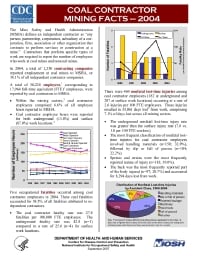Mining Publication: Coal Contractor Mining Facts - 2004
Original creation date: September 2007
Authors: National Institute for Occupational Safety and Health
NIOSHTIC2 Number: 20032740
Pittsburgh, PA: U.S. Department of Health and Human Services, Public Health Service, Centers for Disease Control and Prevention, National Institute for Occupational Safety and Health, DHHS (NIOSH) Publication No. 2007-172, 2007 Sep; :1-2
The Mine Safety and Health Administration (MSHA) defines an independent contractor as "any person, partnership, corporation, subsidiary of a corporation, firm, association or other organization that contracts to perform services or construction at a mine." Contractors that perform specific types of work are required to report the number of employees who work at coal mines and noncoal mines. In 2004, a total of 2,550 contracting companies reported employment at coal mines to MSHA, or 38.1% of all independent contractor companies. A total of 30,228 employees, corresponding to 17,964 full-time equivalent (FTE) employees, were reported by coal contractors to MSHA. Within the mining sectors, coal contractor employees comprised 6.6% of all employee hours reported to MSHA. Coal contractor employee hours were reported for both underground (13.0%) and surface (87.0%) work locations. Five occupational fatalities occurred among coal contractor employees in 2004. These coal fatalities accounted for 38.5% of all fatalities attributed to independent contractors. The coal contractor fatality rate was 27.8 fatalities per 100,000 FTE employees. The underground fatality rate was 42.8 (n=1) compared to a rate of 25.6 (n=4) for surface work locations. There were 469 nonfatal lost-time injuries among coal contractor employees (182 at underground and 287 at surface work locations) occurring at a rate of 2.6 injuries per 100 FTE employees. These injuries resulted in 33,061 days lost5 from work, comprising 7.1% of days lost across all mining sectors. The underground nonfatal lost-time injury rate was greater than the surface injury rate (7.8 vs. 1.8 per 100 FTE workers). The most frequent classification of nonfatal lost time injuries for coal contractor employees involved handling materials (n=150; 32.0%), followed by slip or fall of person (n=104; 22.2%). Sprains and strains were the most frequently reported nature of injury (n=183; 39.0%). The back was the most frequently reported part of the body injured (n=97; 20.7%) and accounted for 8,294 days lost from work. In 2004, five cases of occupational illnesses were reported to MSHA by independent coal contractors. This compares to 13 occupational illness cases reported in 2003. There were two cases of hearing loss or impairment, two cases of black lung (coal workers' pneumoconiosis), and one case of unclassified occupational diseases.

NIOSHTIC2 Number: 20032740
Pittsburgh, PA: U.S. Department of Health and Human Services, Public Health Service, Centers for Disease Control and Prevention, National Institute for Occupational Safety and Health, DHHS (NIOSH) Publication No. 2007-172, 2007 Sep; :1-2
- Coal and metal/nonmetal mining facts - 2008
- Coal and Metal/Nonmetal Mining Facts - 2008 (HTML)
- Coal Contractor Mining Facts - 2001
- Coal Contractor Mining Facts - 2002
- Coal Contractor Mining Facts - 2003
- Coal Contractor Mining Facts - 2005
- Coal Contractor Mining Facts - 2006
- Coal Contractor Mining Facts - 2007
- Mining Fact Sheets
- Rib Falls: A Major Ground Control Issue